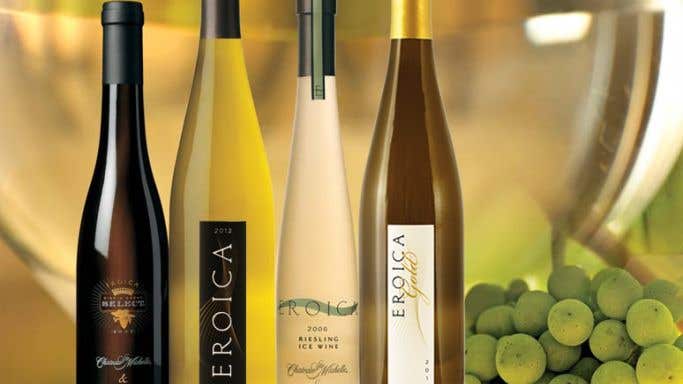2 July 2015 I've chosen this old 2001 article about Washington state as today's Throwback Thursday contribution from the archives to complement Richard's Washington – land of plenty and 150+ Washington tasting notes published this week as a result of his recent trip to Seattle and hinterland. In 2001 it didn't look as though the Great Riesling Plan was going to fly but by 2010 the dominant WA producer Chateau Ste Michelle had hung its hat on Riesling in general and the Eroica brand illustrated here from eroicawine.com in particular.
4 March 2001 Washington clearly has enormous potential as a wine producer. Its wines have a brightness of fruit and acidity that can be lacking in many a California bottle. Growing conditions in the arid Columbia Valley east of the Cascades are almost ideal – so long as you have access to irrigation water and can live with a winter that kills a significant proportion of your vines every six years or so. Summer days are warm, nights cool, for this is semi-desert. And the tanks, barrels and bottles stacked in the wineries that cluster round Seattle apparently managed to survive the recent earthquake!
However, the growers and winemakers of Washington (two particularly disparate groups) are struggling to find their identity. In the second most important wine-producing state in the US (second to California) they seem not quite certain which direction to take.
Land prices are a fraction of those in Napa and Sonoma but wine prices are climbing, just as they have been to the south – except that Washington has much less basic wine to attract the neophyte. New wineries have been bonded at the rate of about 30 a year recently, but these new wineries are all too likely to launch their first vintage at $30 a bottle.
One perceptible influence, incidentally, on all these wannabe wine producers has been Boeing in Seattle. The extracurricular activities its employees are encouraged to embrace include the Boeing Wine Club. A number of new wineries – Camaraderie, Soos Creek and Cadence, for example – are the direct result. If they seem to be able to decide how much to charge (a lot), they are less certain about what to produce.
Washington originally bet on Riesling, which can yield fine wine there, as winemaker Erni Loosen, visiting from the Mosel in Germany, proved in 1999 with an off-dry Eroica and a spectacular botrytised Single Berry Select made with the dominant company, Château Ste Michelle. Alas, poor Riesling. 'Twas not to be, and by the mid 1990s Chardonnay was by far the most planted variety. The results were, for the most part, lacklustre, and in a recent tasting in Seattle, where dozens of producers were invited to submit their finest wine, there were precisely three Chardonnays. Indeed, there were remarkably few white wines, which was a shame since the state clearly has exciting potential for Sauvignon Blanc and, especially, Semillon – see L'Ecole No 41's deliciously fig-like versions. There was even one impressive Madeleine Angevine 1999, a cool-climate grape made west of Seattle by Lopez Island Winery in drizzly Puget Sound.
Chardonnay's popularity was followed by a brief flirtation with Merlot, a sappy, luscious red grape that is clearly more at home in Washington than anywhere else on the American continent, but the Washington producers appear to have lost their nerve – put off perhaps by the irredeemably mass-market image of the grape in California. Washington grape growers, meanwhile, lost a considerable number of Merlot vines in the freeze of 1996, Merlot being particularly susceptible to low winter temperatures.
Today Chardonnay, Merlot and Cabernet Sauvignon are almost equally planted, but by far the majority of the wines submitted for this tasting of the finest were Cabernets or Cabernet blends. Certainly when they are good, they are very good. The best, in broad brushstrokes, combine the luscious, come-hither fruit of a fine California Cabernet with the more disciplined structure and appetising acidity of good red bordeaux. For the moment, at least, comparing like with like, they cost less than either.
Established over-achievers
Andrew Will – sumptuous vineyard-designated Merlots
DeLille – sophisticated red and white bordeaux blends, especially Chaleur Estate
Leonetti – Walla Walla founder with cult status
Quilceda Creek – rich, lively reds
Woodward Canyon – oldtimer delivers great reds consistently.
Names to watch
Betz Family – own brand of the Master of Wine head of Chateau Ste Michelle
Cadence – bright, ex-Boeing red
Cayuse – highly polished Syrah
Col Solare – another (highly priced) joint venture for Chateau Ste Michelle, savoury reds with Antinori of Italy
Eroica – Ernie Loosen's Pacific Riesling
Kestrel – well-mannered claret for ageing
L'Ecole No 41 – well founded faith in Semillon
Matthews – minerally red 1998 built for the long term
Syrah – the most fashionable newcomer . . . getting there
Trey Marie – Trutina 1998 Merlot/Cab blend has real bite.

